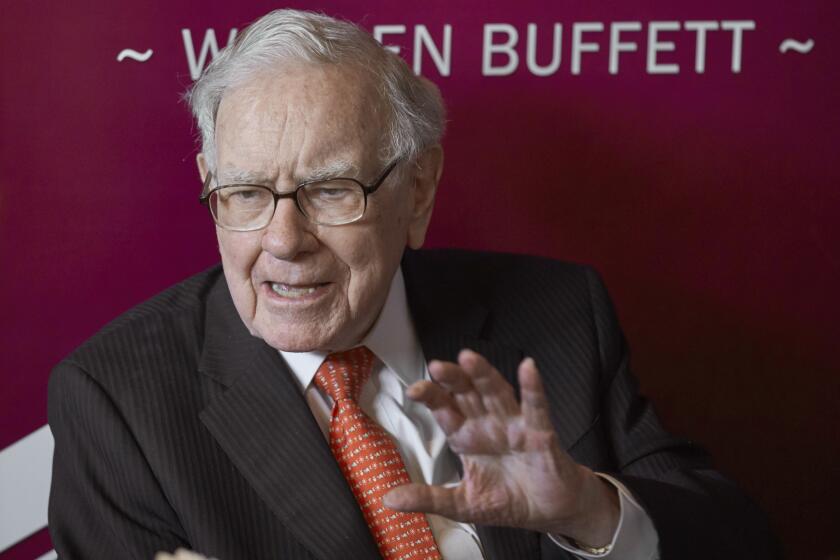High-Tech Jobs Migrate Too as Global Companies Race for Bottom Line
- Share via
BANGALORE, India — The satellite dishes of Bangalore, poking skyward from a city choked with pony carts, mini-cabs and meandering cows, are pumping out India’s best-selling new export: homemade brainpower.
From computer-crammed offices around town, software written by hundreds of young Indians is being beamed back to their employers, American electronics companies.
The Indian handiwork has become, almost overnight, a prime commodity of the information age. The price is right: average pay of $450 a month, one-tenth of what U.S. programmers would receive for the same work.
“Every company here is talking about doubling in size . . . Texas Instruments, Novell, IBM,” said Ranjan Chak, who heads a 100-worker staff in Bangalore for California-based Oracle Software.
Back in America, that kind of talk troubles Joel Snyder.
“There’s downward pressure on U.S. wages,” said Snyder, U.S. chairman of the Institute of Electrical and Electronics Engineers. “The companies seem to want first-rate technical workers who will accept Third World conditions and wages.”
It’s the kind of talk, too, that provokes economic nationalists like Patrick J. Buchanan, who condemn multinational companies for showing “no loyalty to America, no loyalty to anybody.”
The digital “globalization” of India shows that a nation no longer must plod through a low-skill, low-quality economy toward “development.” Today its workers can leapfrog into direct competition with the technologically advanced.
It also underscores the unpredictability of global change in the 1990s, when free-trade policies, portable technology and the death of communism have produced a planetary free-for-all over markets, innovation, cheap labor--a free-for-all that leaves both losers and winners, whether in South Carolina or south India.
Losers began piling up quickly when India liberalized its trade policies in recent years, opening up to foreign investment, lowering protection for home-grown manufacturers. In Bangalore, for example, the domestic motorbike industry, effectively a monopoly, was devastated by Japanese competition.
“It’s a question of the number of people losing out versus the number gaining,” said Narendar Pani, a commentator with India’s Economic Times newspaper. “You’re losing jobs at the factory level of low-skilled labor, and gaining them in software.”
Freer trade incites India’s own Buchanans, like labor leader Raj Krishnan Bhakt, who supported protests against a Kentucky Fried Chicken that opened in Bangalore.
Foreigners “should not be investing in consumer goods like that, but only where their high technology is required,” Bhakt said in an interview in New Delhi.
Bangalore, 350 miles from India’s southern tip, is the home of the Indian Institute of Science and a base for India’s defense industry--fertile ground for high technology. When strict limits on foreign enterprises were lifted, glittering new office buildings quickly rose, bearing the logos of HP and 3M, Compaq and Sun, adding a new architectural layer to an old city of Technicolor Hindu temples and British colonial gingerbread.
Talented young graduates staffing these cyber-shops churn out programming for a world of purposes--scheduling software for U.S. and European airline computers, programs for retail banks and Wall Street investment houses, three-dimensional imaging for medical diagnosis.
Much of it is “shift” work, via satellite, taking over trouble-shooting or other U.S. computer duties while American programmers sleep through their night.
At Oracle’s Bangalore center, Chak said his designers often work on “that 101st product”--software packages the home office might never find time for. Chak and others say this shows they are not taking jobs away from Americans.
“It’s not right to present this as Country X versus Country Y,” said Shyam Sunder, an Indian economist at Pittsburgh’s Carnegie-Mellon University. “There’s elasticity of demand. It’s not simply that work goes to India. When the price of something drops, the total work done will be greater.”
Sound economic theory. But Oracle designer Ranji Srinivas sees more going on.
“We work harder; we’re more productive,” he said. “Americans are definitely losing jobs to Indians.”
But will the Indians lose them next? The electronics giants are plagued by power shortages in Bangalore and unsettled by rising wages. They may have one eye on Indian expansion, but the other is on cheaper alternatives--China’s growing corps of software writers, for example.
“That’s why we must prove our value not only on the basis of cost, but on quality,” Srinivas said.
But in the new global free-for-all, cost will always come first, as German industrialist Hans-Olaf Henkel reminded Indians recently.
“If unions are allowed to hike up labor costs, it can spell doom for Indian industry,” the Federation of German Industries president told The Economic Times.
German economist Klaus Schwab has studied globalization’s rapid-fire changes and concluded the ever-easier movement of production plants worldwide has ushered in an era when “it is possible to have high technology, high productivity, high quality and low wages.”
As global companies pursue that goal, the old industrial heartland stagnates. Europe seems unable to shake double-digit unemployment rates, and American real wages are stalled or declining.
“Jobs” tops the agenda at the industrialized nations’ annual summit this June. Proposed remedies are well known: better basic education, retraining laid-off workers in new skills, government grants to move them to where the jobs are.
Look at it as an “ongoing race,” said Michael Walton, chief economist in a World Bank study on workers in a changed world.
“The question is: Will there be a swift enough capability of the work force to shift, to change their capabilities into the new demand structure?” Walton said in Washington.
He believes there will be, and workers in today’s industrial nations will shift successfully into social services, health, entertainment.
Schwab is not so sure. He fears the pressure for fast-paced readjustment could reach a “breaking point” unless governments and corporations do more to ease the social stress of transition.
But he and other economists sound confident that in the long run, in an integrated world economy, prosperity in the developing nations will help the rich countries prosper, too.
In Bangalore, Subbu Vempati knows where to put his money.
“When I was younger, I was thinking of going to the U.S.,” said the 34-year-old Hewlett Packard software manager. “Since then, the situation has changed dramatically. All the opportunities are here.”
He won’t be alone.
In the next 30 years, the World Bank says, the global labor force will grow by 1 billion people, 99% of them in the developing world. And all will be looking for work.
More to Read
Inside the business of entertainment
The Wide Shot brings you news, analysis and insights on everything from streaming wars to production — and what it all means for the future.
You may occasionally receive promotional content from the Los Angeles Times.










